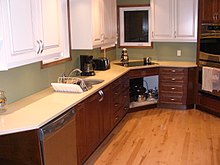Engineered stone is a composite material made of crushed stone bound together by an adhesive to create a solid surface. The adhesive is most commonly polymer resin, with some newer versions using cement mix. This category includes engineered quartz (SiO2), polymer concrete and engineered marble stone.[1] The application of these products depends on the original stone used. For engineered marbles the most common application is indoor flooring and walls, while the quartz based product is used primarily for kitchen countertops[2] as an alternative to laminate or granite.[3] Related materials include geopolymers and cast stone. Unlike terrazzo, the material is factory made in either blocks or slabs, cut and polished by fabricators, and assembled at the worksite.

Engineered stone is also commonly referred to as agglomerate or agglomerated stone, the last term being that recognised by European Standards (EN 14618), although to add to the terminological confusion, this standard also includes materials manufactured with a cementitious binder.[citation needed] The quartz version (which end consumers are much more likely to directly deal with) is commonly known as 'quartz surface' or just 'quartz'.[4]
- ^ Sara Black (August 1, 2013). "Cast polymer categories". compositesworld.com. Retrieved July 9, 2018.
- ^ "Q&A: Which countertop material is toughest?". Consumer Reports. July 9, 2007. Retrieved July 9, 2018.
- ^ Jon Coile (May 27, 2017). "Open floor plans and parking among buyers' biggest desires". The Washington Post. Archived from the original on 10 July 2018. Retrieved July 9, 2018 – via PressReader.
- ^ Deborah K. Dietsch (January 21, 2017). "Quartz supplants granite as people's choice for countertops". The Washington Post. Archived from the original on 10 July 2018. Retrieved July 9, 2018 – via PressReader.